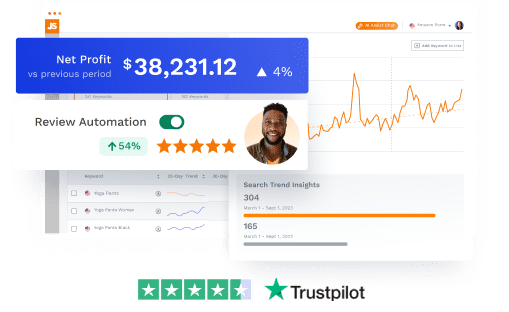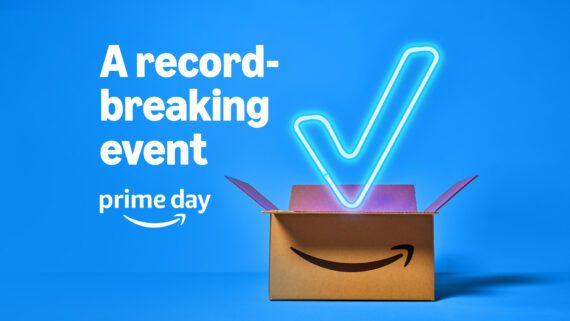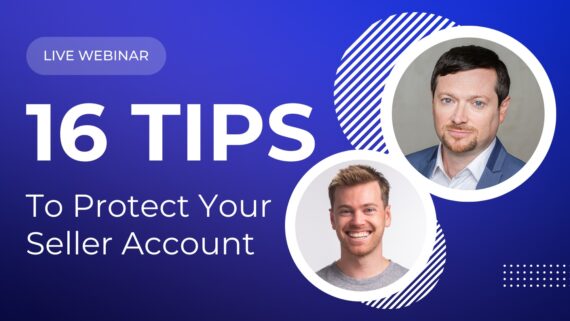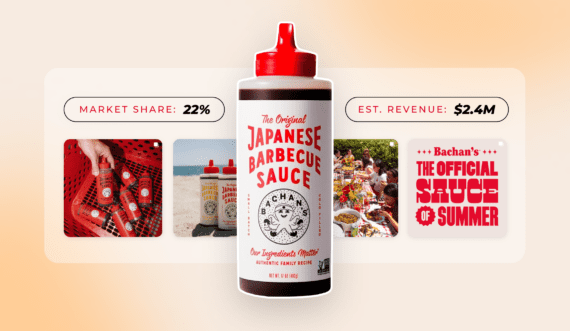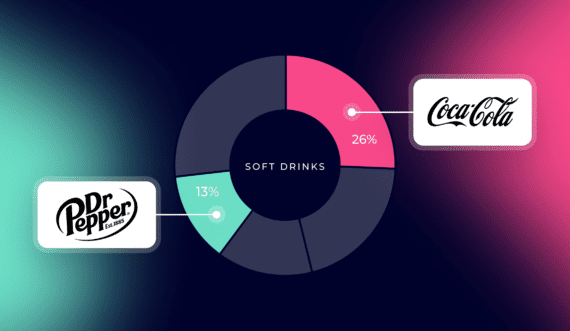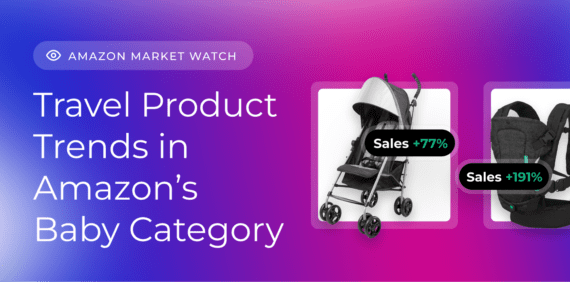Content
expand_moreIs selling on Amazon worth it in 2024? In short: yes. But let’s go over why.
In 2023, Amazon’s revenue was a whopping $574 billion, up from $514 billion in 2022 — and nearly one quarter (23%) of that revenue is driven by third-party sellers! Of those third-party sellers we surveyed, 82% of them use Fulfillment by Amazon (FBA) to fulfill orders in their Amazon business.
While the competition has increased on Amazon and other ecommerce platforms, so has the demand for online shopping — 51% of consumers start their product searches on Amazon.
In this article, we’ll explain why selling on Amazon FBA is still worth it in 2024 and beyond.
Want to learn more about selling on Amazon? Check out our complete guide.
How much do Amazon sellers make?
This is a question that every new seller asks. Our complete guide covers how much Amazon sellers make in full, but let’s look at some stats on what current sellers earn in sales revenue and net profit from selling products on Amazon FBA.
Let’s see some monthly revenue numbers:
- 40% of Amazon sellers sell anywhere from $1,000 to $25,000/month
- 30% of Amazon sellers report sales above $5,000/month
- 31% of sellers make under $500/month in sales
| Monthly sales | Percent of sellers |
|---|---|
| Under $500 | 31% |
| $501-$1,000 | 17% |
| $1,001 – $5,000 | 22% |
| $5,001 – $10,000 | 11% |
| $10,001 – $25,000 | 7% |
| $25,001 – $50,000 | 5% |
| $50,001 – $100,000 | 4% |
| $100,001 – $250,000 | 1% |
| $251,000 – $500,000 | 1% |
Many sellers have recently begun to sell products on Amazon, and, with the power of Amazon’s supply chain and massive customer base, they are seeing early signs of success.
Is selling on Amazon profitable?
Revenue doesn’t tell the whole story of someone’s business. You could have $1 million in sales, but you’re not making any money if your costs are over that.
Compared to other traditional businesses such as brick-and-mortar, Amazon sellers see relatively higher profit margins.
- 57% of Amazon sellers achieve profit margins greater than 10%
- 28% of Amazon sellers earn at least a 20% profit margin
- 30% of Amazon sellers have seen lifetime profits over $50,000
Not too bad, considering many new sellers start this venture as a side hustle!
| Profit margin for SMB sellers | Percent of sellers |
|---|---|
| ~1-5% | 12% |
| 6-10% | 16% |
| 11-15% | 13% |
| 16-20% | 15% |
| 21-25% | 15% |
| 26-50% | 13% |
| 51-100% | 1% |
| Not currently profitable | 13% |
These numbers are encouraging to see but it’s worth noting that 13% are not yet profitable. If you are unsure of your profits and losses, you can get a full financial picture of your business by using a tool such as Sales Analytics to track your sales and profits.
A financial command center for your Amazon business.
Jungle Scout’s Sales Analytics lets you track Amazon sales data in real time to instantly see profits, keep track of fees, and understand the financial health of your business.
Pros and cons of selling on Amazon
FBA is an incredible business model that allows anyone, no matter their ecommerce experience, to open an online store and list products to millions of potential customers. But as in anything, the good comes with some downsides. Let’s quickly go over some of the pros and cons of selling on Amazon to help you determine if Amazon FBA is worth it.
Pros of selling on Amazon
- Access to Amazon’s loyal customer base: Amazon.com receives nearly 3 billion visits per month and has over 300 million Prime customers worldwide. As a small, single-person business, you can list products on a website that receives millions of visits per day.
- If you use FBA, Amazon takes care of logistics: If you use Amazon’s FBA program, you will send your inventory to Amazon’s fulfillment centers, and they will handle the storage, order fulfillment, and even customer service for you.
- Prime shipping: When sellers use FBA to fulfill their orders, your products will receive the Prime badge and have access to Amazon’s sizable Prime customer base that orders exclusively from Prime sellers.
Cons of selling on Amazon
- Storage fees: Since you will be storing your items in an Amazon fulfillment center if using FBA, you will need to pay storage fees. There are two types of storage fees: monthly and aged. Learning to manage your inventory correctly will help you avoid costly storage fees.
- FBA fees: For Amazon to store, pick, pack, and ship out your orders, they must charge you a fee. FBA fees depend on the size and weight of your product. Between FBA fees and referral fees, it is typically 30-40% of your product price.
- Easy for customers to return items: Because of Amazon’s generous return policy, some sellers may experience high return rates on their products. While it is convenient for customers, it’s a hassle for sellers.
How much money and time does it take to sell on Amazon?
You know how much money you can potentially make, but how much does it cost to start your Amazon business? Not only will it require an upfront monetary investment but also an investment of your time.
Money
One of the biggest questions asked here at Jungle Scout is, “How much money should I start with?” While most sellers (64%) started their Amazon business with around $5,000 or less, 25% started with less than $1,000, and 16% started with under $500!
If you plan to launch your own private label brand, yes, you will need to start with more money. But if you want to start earning money as soon as possible, retail arbitrage or wholesale are great options for smaller budgets.
Again, keep Amazon fees in mind when deciding whether or not selling on Amazon is worth it. Before investing in inventory, ensure your products will be profitable after all fees if sold on Amazon at your chosen sales price.
What fees will you encounter as an Amazon seller?
- Referral fees. The referral fee is paid by all Amazon sellers, whether you fulfill orders using FBA or FBM. It is the “commission” paid to Amazon for each item sold on their platform. Typically, this fee is a flat percentage of 15% or less.
- FBA fees. If you use Fulfillment by Amazon for your products, Amazon will charge you an FBA fee, which depends on the weight and size of your products. For example, if you sell a small standard-size product that is 15″ x 12″ x 0.75″ or less and weighs 4 oz or less, you’ll pay a $3.22 fulfillment fee.
- FBA storage fees. If you store your products with Amazon, you will be charged a monthly storage fee for the space your products use. For example, from January – September, Amazon charges $0.87 per cubic foot.
- Subscription fee. If you have a professional seller account on Amazon, you will be charged $39.99 per month.
Learn the true costs of selling on Amazon.
How did sellers fund their business?
When first starting an Amazon business, 81% of sellers chose to bootstrap their business or use personal savings to start. If you don’t have much to begin with, I recommend bootstrapping (this means you start with a small amount of money and continue to reinvest) or personal savings.
Using credit cards or loans is risky for a new seller because it will be challenging to pay back what you owe if you purchase poor inventory. Having said that, 6% of sellers borrowed money from a family member, 23% used a credit card, and roughly 15% received some type of business loan to start.
How long did it take them to turn a profit?
Amazon sellers are profiting much sooner compared to a typical small brick-and-mortar business. While it may take the latter 2+ years to turn a profit, 22% of Amazon sellers reported it took less than 3 months to turn a profit, and 58% are profitable within their first year. No, Amazon is not a “get rich quick” scheme, but it is quite possible to start profiting early.
This is not the case for every seller, though. For sellers launching their brand, it may take a bit longer to start seeing some profit. 16% of sellers stated it took 3-6 months, and 11% reported it took roughly 1-2 years before turning a profit. That is common for a private label product, especially during the launch phase.
Sellers are spending money on promotions and advertising to help get the ball rolling on their listings.
Discover all the different ways to make money on Amazon (by selling or not).
Time
To successfully sell on Amazon, you need to put in the time it takes to be successful. If you are consistent, you can quickly launch your first product within 3 months, just like 48% of other Amazon sellers have done. 23% launched in less than 6 weeks!
Don’t feel like you need to get up and running that quickly, though. 19% of sellers took 6 months to a year to launch their Amazon business.
Go at your own pace and what makes you feel most comfortable.
How much time do sellers spend per week on their business?
In the beginning stages, you will likely be spending more time on your venture. 12% of sellers spend 21-30 hours per week on the business while 16% have gone full-time selling on Amazon and are working nearly 40 hours or more.
If you utilize FBA to handle all order logistics, you could reasonably spend less than 10 hours per week on your business, like 50% of sellers do.
The time you put into your business depends on what you want out of it.
For more information on what it takes to sell on Amazon, check out our State of the Seller Report.
Is it too competitive to sell on Amazon?
While the competition has increased over the past couple of years, selling on Amazon can still be profitable for new sellers, as you learned above. In fact, if you sell in the U.S. marketplace, it is considered the least competitive Amazon marketplace.
In any business you decide to pursue, there will always be competition — and competition is good because it means there is a market for your products.
Nearly 600,000 new sellers will have signed up to sell on Amazon this year. Yes, that is a vast number of sellers but remember that Amazon’s market share continues to grow every month, quarter, year — however way you want to look at it.
So while more sellers may make things more challenging for existing sellers, you won’t necessarily be stealing sales from each other but sharing a much larger and growing customer base.
If you are a new seller, don’t just jump into a product without doing any research or just because it is “popular.” Take your time and do the proper product research needed to be successful in ecommerce and Amazon.
Is Amazon FBA worth it? Final thoughts
Yes, Amazon is competitive. It takes a decent amount of time and money to start, and contrary to popular belief, it isn’t a set-it-and-forget-it type of venture. Navigating an Amazon FBA business requires learning, perseverance, and hard work. But is selling on Amazon worth it? Ultimately, that answer is up to you, but we say yes.
In our opinion, there are far more upsides to selling on Amazon than downsides. Will every seller who launches a product on Amazon be successful? Probably not — but if you put in the work, constantly improve and learn from your mistakes, you will be successful at selling on Amazon.
Anyone can do it. Why can’t you?
How do I learn to sell on Amazon?
There certainly is a learning curve involved to navigate Seller Central efficiently. It isn’t surprising that 29% of Amazon sellers say they need more training and that 24% are confused about how selling on the platform works.
For all the opportunities available to entrepreneurs, the thought of selling online can be daunting: 39% of sellers are concerned about competition, and 33% are intimidated by the process of selling online.
From opening an account to launching your first product, our guide walks you through every step of the Amazon selling journey.
Seller resources
Fortunately, countless Amazon sellers have achieved success on their own, with the help of excellent educational content available online — and a lot of it is free. On Jungle Scout’s Free Resources page, for example, you can find a wealth of quality content such as blog articles, reports, and videos; and more robust work such as our complete, in-depth guide on How to Sell on Amazon for Beginners in 2024. Once you’ve gained traction and can set aside the budget to continue your seller education, you can level up and take courses, hire a coach, and attend industry events.
Here are other valuable resources from Jungle Scout:
Do you have any more questions about selling on Amazon FBA? Let us know in the comments!
Take your Amazon business to the next level.
Leverage Jungle Scout’s suite of data intelligence tools to start and grow your Amazon business.
Brian Connolly is an Amazon seller, ecommerce expert, and writer for Jungle Scout. He lives in the New Jersey Shore area with his wife and cat. When he isn’t writing advice online for aspiring and experienced Amazon sellers for Jungle Scout, he spends his free time boating, fishing, and selling boating-themed items on his Amazon business.


